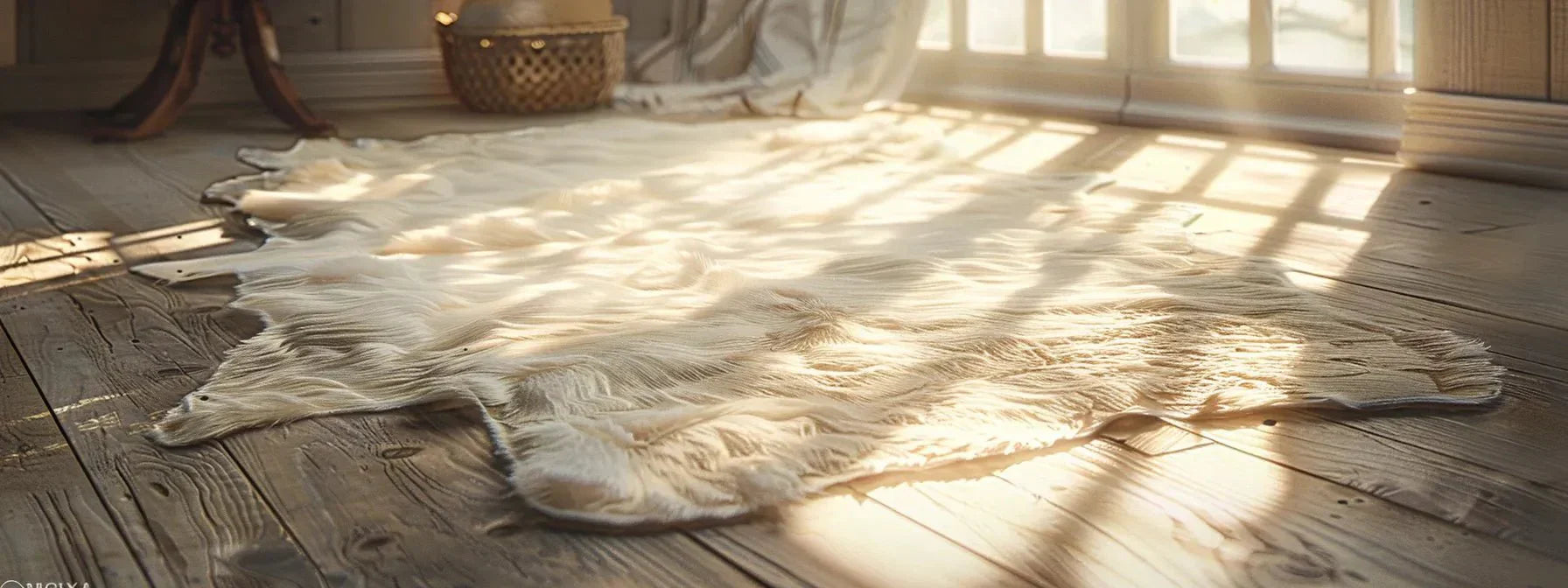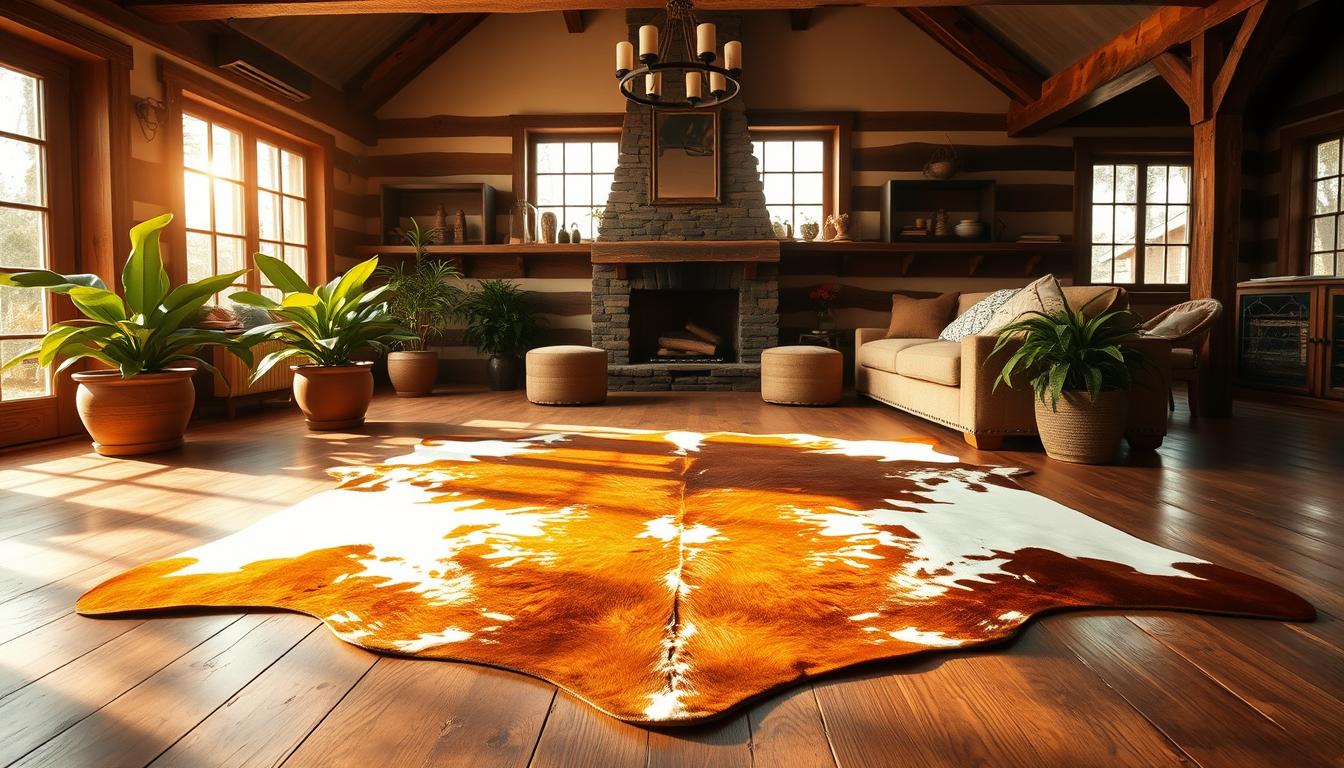
6 Bold Reasons to Choose a Hide Rug
Could a single piece of decor elevate your home’s style while lasting decades? Leather floor coverings crafted from cattle hides aren’t just functional—they’re conversation starters. Each piece showcases nature’s artistry, blending practicality with striking visual appeal.

These rugs begin as complete animal skins preserved through specialized methods. Chrome tanning offers quick results, while vegetable tanning uses eco-friendly plant extracts. Both techniques create durable surfaces that resist wear, perfect for high-traffic areas.
Natural dimensions vary between 20 and 50 square feet, adapting to rooms of all sizes. Original markings like spots or swirls remain visible, though some artisans add vibrant dyes for bolder looks. This customization ensures no two pieces ever look identical.
Modern designers love their versatility. Neutral tones complement minimalist spaces, while bold patterns anchor eclectic rooms. Unlike mass-produced alternatives, each rug tells its own story through texture and color contrasts.
Key Takeaways
- Natural cowhide rugs retain original animal patterns, ensuring one-of-a-kind designs
- Choose between chrome-tanned (fast) or vegetable-tanned (eco-friendly) processing
- Sizes range from 20–50 sq ft, accommodating various room layouts
- Artisans sometimes enhance hides with exotic dyes for custom color options
- Durable leather construction withstands heavy foot traffic and daily use
- Increasingly popular in contemporary interiors for organic texture contrast
Introduction to Hide Rugs and Their Unique Appeal
In a world of mass-produced decor, genuine cowhide stands out with DNA-level uniqueness. No two pieces share identical markings – each carries nature's fingerprint through irregular patterns and color variations.
Material Mastery Beyond Replication
Synthetic fibers can't match organic textures. Unlike machine-made alternatives, these natural floor pieces develop richer character over time. Their surface responds uniquely to light changes, creating dynamic visual interest.
| Feature | Cowhide | Wool | Jute |
|---|---|---|---|
| Unique Patterns | 100% | 15% | 5% |
| Texture Depth | 3D surface | Flat weave | Linear fibers |
| Maintenance | Shake clean | Vacuum | Spot clean |
| Eco-Friendliness | Byproduct | Farm-raised | Crop-dependent |
Design Versatility Redefined
Use these statement pieces to anchor minimalist spaces or energize eclectic layouts. Their natural hues blend seamlessly with existing schemes, while bold patterns command attention. Designers often layer them over hardwood to create instant focal points.
Bedrooms gain cozy warmth when layered beside beds, while angular living spaces benefit from organic curves. The rugs' irregular shapes soften rigid architecture, proving particularly effective in modern boxy room designs.
Understanding What is a Hide Rug: History and Production
The creation of hide rugs marries tradition with modern sustainability efforts. Artisans select only premium cattle skins marked by distinctive natural patterns and flawless surfaces. This careful curation ensures each piece becomes a functional artwork rather than ordinary floor covering.

The Curing and Tanning Process
Selected hides undergo rigorous preparation. Workers first preserve skins through a two-week salt treatment, removing impurities while locking in natural textures. This curing phase prevents decay and prepares materials for transformation.
Tanning methods define a rug's eco-footprint. Vegetable-based processing uses oak bark extracts over six months, creating durable surfaces through natural chemistry. Chrome alternatives accelerate production but release harmful byproducts into waterways.
| Process | Time Required | Environmental Impact | Durability |
|---|---|---|---|
| Vegetable Tanning | 6 months | Low | Exceptional |
| Chrome Tanning | 2 days | High | Good |
From Byproduct to Beautiful Decor
Rug production solves a critical meat industry challenge. Over 5 million cattle hides become waste annually in the U.S. alone without proper processing. Tanneries convert this potential landfill burden into long-lasting decor through skilled craftsmanship.
Modern techniques maintain historical methods while meeting eco-standards. Your chosen rug represents smarter resource use – transforming overlooked materials into heirloom-quality furnishings. This circular approach reduces environmental strain without sacrificing luxury.
Exploring the Benefits of Real Cowhide Rugs
Your space deserves floor art that blends nature's craftsmanship with practical elegance. Real cowhide rugs deliver both, transforming rooms through organic textures and responsible sourcing. These pieces convert industrial byproducts into enduring decor statements.
Nature's Signature Designs
Every genuine cowhide rug carries distinct biological fingerprints. Irregular spots, swirls, and color gradients mirror the animal's life journey. Unlike printed replicas, these variations create depth that evolves under changing light conditions.
| Feature | Real Cowhide | Synthetic Rugs |
|---|---|---|
| Unique Patterns | 100% Natural | Mass-Produced |
| Eco-Impact | Upcycled Material | Plastic-Based |
| Texture Complexity | 3D Grain | Flat Surface |
| Lifespan | Decades | 3-5 Years |
The natural grain structure acts like armor against wear. Dense collagen fibers in the hide's middle layer resist crushing, maintaining shape despite furniture weight or foot traffic. This biological design outlasts synthetic alternatives.
Choosing cowhide rugs supports circular economies. Over 80% of materials used would otherwise become waste. Your selection reduces landfill contributions while adding museum-worthy artistry to floors.
No two pieces share identical markings – your decor becomes as singular as a fingerprint. These rugs defy trends through timeless patterns that adapt to evolving styles. They age like fine leather, gaining character with each passing year.
Design and Aesthetic Versatility
Ever considered how a floor covering could redefine your entire space? Cowhide rugs master this design magic, adapting effortlessly to diverse interiors while solving common decor dilemmas.
Enhancing Your Room's Ambiance
Position one beneath a coffee table to anchor living room conversations. The natural patterns pop against hardwood floors, creating instant visual drama. In bedrooms, their soft texture adds warmth underfoot while balancing sleek modern furniture.
Architectural edges soften when organic rug curves meet rigid walls. This contrast works wonders in boxy rooms, breaking monotony without overwhelming the space. High-traffic areas like entryways benefit too – their durable surfaces maintain sharp appearance despite daily use.
Mixing Rustic Charm with Modern Trends
Designers blend these pieces with metallic accents for industrial lofts or pair them with linen fabrics in coastal homes. Three standout techniques:
- Contrast play: Layer neutral hides under vibrant furniture
- Texture stacking: Combine with jute rugs for depth
- Color bridging: Match hide markings to wall art tones
Explore living room transformations where these rugs shift from background players to starring roles. Their versatility lies in balancing statement-making power with subtle adaptability.
Durability and Quality: A Long-Term Investment
Looking for floor decor that improves with age? Cowhide rugs deliver unmatched longevity while maintaining their luxurious feel. Consumer economics research reveals these pieces save 63% in replacement costs compared to synthetic alternatives over a 10-year period.
Resilience Under Heavy Traffic
High-traffic zones demand tough materials. Dense collagen fibers in cowhide leather withstand daily wear better than wool or jute. A comparative study shows:
| Material | Average Lifespan | Foot Traffic Tolerance | Cost Per Year |
|---|---|---|---|
| Cowhide | 15-25 years | Extreme | $12 |
| Synthetic | 3-5 years | Moderate | $41 |
| Wool | 8-12 years | High | $27 |
Entryways and hallways showcase their strength best. Unlike flat-woven rugs that show matting, cowhide's 3D grain hides minor imperfections while resisting permanent creases.
Maintaining Softness and Suppleness Over Time
Proper care transforms these pieces into family heirlooms. The leather develops a rich patina through natural oils in household air. Simple maintenance steps:
- Shake outdoors monthly
- Wipe spills with damp cloth
- Rotate seasonally for even wear
"Our 12-year-old cowhide rug feels softer now than when we bought it. The colors deepen like vintage leather jackets."
This natural aging process creates unique character synthetic materials can't replicate. Your investment gains value through both aesthetics and enduring performance.
Sustainable Luxury: Environmental and Ethical Considerations
Every design choice carries ecological consequences—some visible, others hidden beneath the surface. Choosing cowhide floor coverings addresses both, transforming potential waste into enduring artistry while supporting responsible resource use.

Closing the Resource Loop
Over 56 billion animals enter global food systems annually. Without leather production, their hides would overwhelm landfills, releasing methane as they decompose. Tanneries intercept this waste stream, converting 85% of discarded skins into durable decor.
| Material | Production Energy | Waste Generated | Biodegradability |
|---|---|---|---|
| Natural Cowhide | Low | Minimal | Yes |
| Synthetic Fiber | High | 8.9 lbs/sq yd | No |
Ethical Sourcing in Practice
These rugs don’t drive animal farming—they utilize existing byproducts from the meat industry. Cattle are raised primarily for food, making hide processing an ethical bonus rather than primary motivation.
"Repurposing agricultural byproducts reduces pressure on virgin resources. Cowhide utilization prevents 3.2 million tons of potential landfill waste annually."
Petroleum-based alternatives require 12x more energy to produce. Your selection directly lowers pollution linked to synthetic manufacturing. This circular approach honors the animal’s life through complete resource stewardship.
Caring for Your Hide Rug: Cleaning & Maintenance Tips
Proper care transforms your decor into lasting heirlooms. These natural floor pieces require specific techniques to maintain their luxurious texture and vibrant patterns. Start with routine practices that protect against daily wear while enhancing durability.
Regular Cleaning Techniques
For everyday upkeep, gently vacuum along the natural grain using a brush attachment. This prevents dirt from settling into the leather’s pores. Occasional light steam cleaning refreshes fibers without oversaturation—keep moisture levels low to preserve structural integrity.
Spot Treatment and Stain Prevention
Accidents demand immediate action. Blot liquid spills with absorbent cloths, then dab gently using a mild soap solution. Tackle grease marks with eucalyptus oil, applying sparingly to avoid discoloration. Rotate your rug seasonally to ensure even exposure in sunlit areas.
Direct sunlight gradually fades bold patterns, so position these pieces away from intense window glare. Discover advanced preservation methods in our professional care guide, which details specialized treatments for maintaining supple textures over decades.
FAQ
How can I tell if a cowhide rug is genuine?
Genuine cowhide rugs have natural markings, irregular shapes, and slight variations in hair length. Check for a leather backing and unique grain patterns. Avoid synthetic materials or overly uniform designs, which indicate faux versions.
Are cowhide rugs environmentally friendly?
Yes! These rugs are a byproduct of the meat industry, reducing waste. Ethical manufacturers use eco-conscious tanning processes to minimize pollution, making them a sustainable choice for decor.
Do cowhide rugs shed or wear down over time?
High-quality cowhide rugs retain their durability for years. Occasional shedding may occur initially but stops after gentle cleaning. Avoid heavy moisture and direct sunlight to preserve softness and color.
Can I use cowhide rugs in high-traffic areas?
Absolutely. Their natural resilience makes them ideal for busy spaces like living rooms. Rotate the rug periodically to ensure even wear and maintain its appearance.
How do I clean stains without damaging the material?
Blot spills immediately with a dry cloth. For tougher stains, use a damp cloth and mild soap, then air-dry. Avoid harsh chemicals, which can strip the leather’s natural oils.
Do cowhide rugs work with modern interior styles?
Yes! Their organic textures and neutral tones complement minimalist or contemporary designs. Pair them with sleek furniture for a balanced mix of rustic charm and modern elegance.
Why do some cowhide rugs have uneven edges?
Natural edges are part of their authentic appeal, showcasing the hide’s original shape. Trimmed edges indicate customization, but many prefer the rugged, organic look for a statement piece.
Can sunlight fade a cowhide rug’s color?
Prolonged exposure to direct UV rays may lighten darker shades over time. Place them in shaded areas or use window treatments to protect vibrant patterns and maintain warmth in your space.









